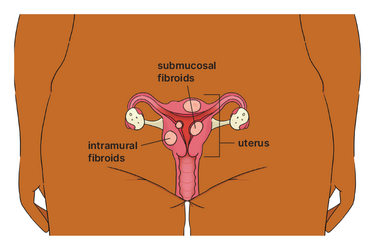On this page, read about fibroids, including the symptoms, causes, treatments and when to see your doctor.
What are fibroids?
Symptoms of fibroids
Causes of fibroids
How are fibroids diagnosed?
How do fibroids affect fertility?
Treatments for fibroids
When to see your doctor about fibroids
Related resources
Fibroids are noncancerous growths found in the muscle wall of the uterus. They can vary in size from a pea to a rockmelon or bigger.
Fibroids can grow on the outer wall of the muscle (subserosal), within the muscle wall (intramural), on the inner wall lining the cavity of the uterus (submucosal), or a combination of these.
Up to 70% of women aged under 50 have fibroids. After menopause, fibroids usually shrink and may even disappear.

If you have fibroids, you may not have any symptoms. But 20% to 30% of women experience symptoms such as:
Other symptoms may include:
We don’t know exactly what causes fibroids, but we do know the female hormones oestrogen and progesterone stimulate the growth of fibroids.
Some factors may increase the risk of developing fibroids, for example:
Fibroids can be diagnosed in different ways, for example:
Fibroids can cause fertility problems, depending on the size and location of the fibroids. They can also cause pregnancy complications. Ask your doctor for more information.
Most fibroids don’t need treatment, unless you’re planning to get pregnant or your symptoms stop you from doing daily activities.
If fibroids don’t affect your daily life, you can choose to leave them untreated.
Your doctor may recommend different medicines to treat your fibroids. For example, mefenamic acid tablets, tranexamic acid tablets or hormone medicines such as the Pill or an IUD.
Your doctor may recommend a combination of medicines to shrink your fibroids, usually when fertility is an issue.
Ask your doctor about the benefits and risks of each medicine.
Note that after you stop treatment, your fibroids can grow back.
You may be able to treat your fibroids with radiological treatment. For example:
You may need surgery to remove your fibroids. The type of surgery will depend on the size and position of your fibroids. Ask your doctor or specialist for more information.
See your doctor if you experience symptoms such as:
This content has been reviewed by a group of medical subject matter experts, in accordance with Jean Hailes policy.
© Jean Hailes Foundation. All rights reserved.